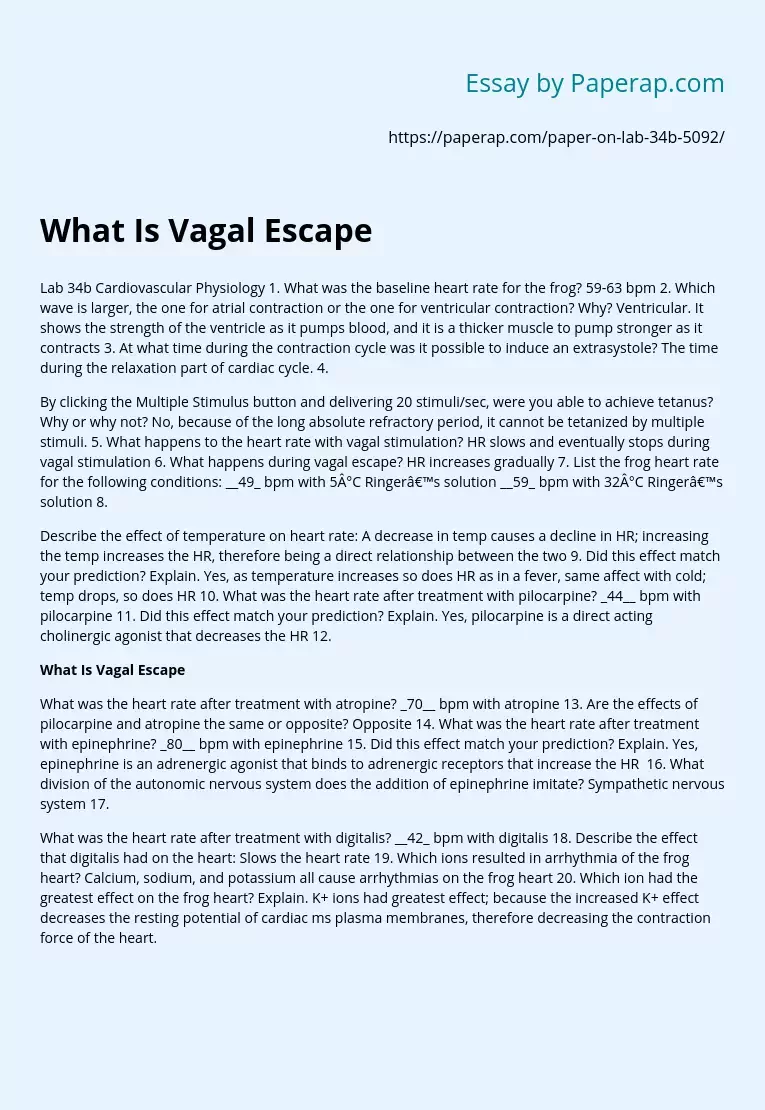What Is Vagal Escape
Lab 34b Cardiovascular Physiology 1. What was the baseline heart rate for the frog? 59-63 bpm 2. Which wave is larger, the one for atrial contraction or the one for ventricular contraction? Why? Ventricular. It shows the strength of the ventricle as it pumps blood, and it is a thicker muscle to pump stronger as it contracts 3. At what time during the contraction cycle was it possible to induce an extrasystole? The time during the relaxation part of cardiac cycle. 4.
By clicking the Multiple Stimulus button and delivering 20 stimuli/sec, were you able to achieve tetanus? Why or why not? No, because of the long absolute refractory period, it cannot be tetanized by multiple stimuli.
5. What happens to the heart rate with vagal stimulation? HR slows and eventually stops during vagal stimulation 6. What happens during vagal escape? HR increases gradually 7. List the frog heart rate for the following conditions: __49_ bpm with 5°C Ringer’s solution __59_ bpm with 32°C Ringer’s solution 8.
Describe the effect of temperature on heart rate: A decrease in temp causes a decline in HR; increasing the temp increases the HR, therefore being a direct relationship between the two 9.
Did this effect match your prediction? Explain. Yes, as temperature increases so does HR as in a fever, same affect with cold; temp drops, so does HR 10. What was the heart rate after treatment with pilocarpine? _44__ bpm with pilocarpine 11. Did this effect match your prediction? Explain. Yes, pilocarpine is a direct acting cholinergic agonist that decreases the HR 12.
What Is Vagal Escape
What was the heart rate after treatment with atropine? _70__ bpm with atropine 13.
Are the effects of pilocarpine and atropine the same or opposite? Opposite 14. What was the heart rate after treatment with epinephrine? _80__ bpm with epinephrine 15. Did this effect match your prediction? Explain. Yes, epinephrine is an adrenergic agonist that binds to adrenergic receptors that increase the HR 16. What division of the autonomic nervous system does the addition of epinephrine imitate? Sympathetic nervous system 17.
What was the heart rate after treatment with digitalis? __42_ bpm with digitalis 18. Describe the effect that digitalis had on the heart: Slows the heart rate 19. Which ions resulted in arrhythmia of the frog heart? Calcium, sodium, and potassium all cause arrhythmias on the frog heart 20. Which ion had the greatest effect on the frog heart? Explain. K+ ions had greatest effect; because the increased K+ effect decreases the resting potential of cardiac ms plasma membranes, therefore decreasing the contraction force of the heart.
What Is Vagal Escape. (2019, Dec 05). Retrieved from https://paperap.com/paper-on-lab-34b-5092/

